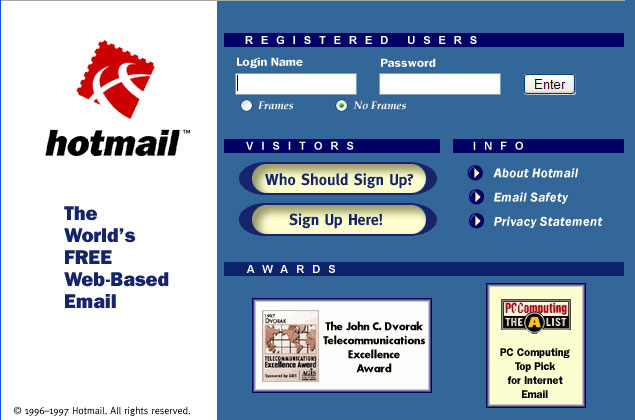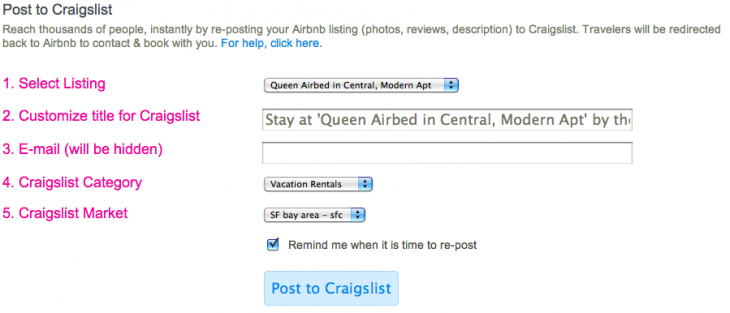
John McLaughlin is a start-up founder and entrepreneur based in Manhattan and a writer for Fueled, a mobile development company based in New York City.
These days, it seems like some tech companies go from zero to a million users overnight. The growth of these firms — Airbnb and Uber might service as recent examples — can seem magical… but it’s not. What’s the so-called magic sauce for these companies?
To attain this kind of rapid growth, it’s imperative to look outside of typical, run-of-the-mill marketing strategies like paid advertising and to start thinking creatively about how to engage users and spread the word about your site. Below are some examples of growth hacks that have helped some of the countries largest tech giants get where they are today.
1. Hotmail’s “Get Your Free Email at Hotmail” Tagline
Rather than blowing its marketing budget on advertising, groundbreaking browser-based email service Hotmail elected to leverage a free resource it already had— existing users.
Hotmail already had about 20,000 users one month after launching in 1996 and it opted to market its service directly to the friends, family and colleagues of those users by employing a simple strategy: It added a tagline, “Get Your Free Email at Hotmail,” at the end of each existing user’s outgoing mail.
When a Hotmail user sent out an email on his or her account, the recipient could click on the tagline link, which would direct them to a page where they could set up their own account. As a result, the company userbase not only skyrocketed to 1 million users within 6 month, but the email startup also executed one of of the web’s earliest growth hacks (though the term wouldn’t be coined for another fourteen years).
2. Paypal’s eBay Dominance
Half platform hack, half “fake it ‘til you make it,” PayPal, founded in 1998, managed to gain a remarkable degree of traction by manufacturing its own popularity on eBay. When it figured eBay as a vital distribution platform, eBay created a bot that purchased goods on the auction site using only PayPal as a payment method.
Seeing the increasing popularity of PayPal for payment, eBay sellers began offering it so they didn’t miss out on sales. Not only did this make Paypal seem more popular than it was, it got sellers to actually use the service, helping them realize it really was a more convenient payment method.
3. YouTube’s Embed Code
Another classic example of platform hacking: YouTube chose to focus on MySpace as a means of reaching its target audience. At the time, in 2005 with nearly 25 million unique users, MySpace was the top social network, particularly for bands and their fans, but sharing videos on the site was next to impossible.
Other video sites like YouTube had avoided allowing blogs and other sites to embed their videos because they wanted to keep the traffic on their own sites – plus, they didn’t want to pay the hosting costs associated with supporting traffic to other people’s sites. YouTube shouldered the cost in exchange for a huge boost in brand recognition. That initial traction helped it grow into the powerhouse it is today, with over a billion users.
4. Dropbox’s Referral Program
When Dropbox was first starting out, it experimented with paid ads and found that the cost to acquire a new customer was much higher than the average customer lifetime value, which is a sure way to run out of money before reaching profitability. It chose to look elsewhere for growth, designing an easy-to-use referral program that awarded 500MB of free Dropbox storage space to each party pending signup.
Not only is this 1GB of space far cheaper than paid advertisement, but referrals from friends are also much more trustworthy than anonymous ads. Dropbox sent out 2.8 million of these direct referral invited in April 2010.
This example of a low-cost, high-impact growth hack – that accomplished the difficult task of making a file storage system seem like an exciting, and exclusive, club – increased Dropbox signups dramatically. In a 15-month period, the company went from having 100,000 users to having 4 million users.
5. Facebook’s Closed Network
No single hack can possibly be responsible for the remarkable growth at the social network giant Facebook. Nevertheless, this initial hack helped to start them off on a solid foundation that made later growth possible.
Beginning as a contained network (versus the free-for-all that was Friendster) and then slowly expanding—from Harvard, to a handful of colleges, to all colleges, and so on—allowed Facebook to remain at critical mass at every stage of growth. The fact that it was a closed network made it seem exclusive, increasing the appetite for it from socially hungry college kids.
6. Twitter’s Recommended Followers
Sometimes, the greatest growth hacks can see obvious in retrospect, but many tech companies overlook obvious ways to increase the virality of their products. In the early days, Twitter had a bit of a retention problem—new users poured in, but very few actually engaged with the site and became active users.
Rather than investing in the standard retargeting ads or email newsletters, the company attempted to figure out what it was that separated those who kept coming back and those who joined and never returned. It learned that following at least five to 10 accounts resulted in a much higher likelihood of engagement so then Twitter rebuilt a new user experience to encourage following others. The positive impact on its retention was dramatic and instant.
7. Airbnb’s Craigslist Cross-Posting
Yet another example of a platform hack, a simple yet brilliant bot allowed users listing their properties on the fledgling rental space Airbnb to cross-post them to Craigslist in one click.
Taking advantage of Craigslist’s well-established user base not only allowed Airbnb to get its name in front of as many new users as possible, but it also helped to ensure that the properties they listed for rent were booked more often—making listing with them more lucrative for users.
8. Pinterest’s Invitation-Only Signup
Taking a cue from Facebook’s early growth, the social bookmarking site Pinterest was initially invitation-only. Anyone was free to request an invitation, after which they received an email notifying them that the waiting list was long but they’d be allowed in as soon as possible.
Whether or not this was actually true, it served to generate buzz and made Pinterest seem that much more desirable to early users.
9. Instagram’s Cross-Posting to (Almost) Any Platform
Taking the platform hack concept to another level, Instagram made it quick and easy for users to cross-post to Facebook, Twitter, Tumblr, Foursquare, and more.
This was undeniably good for users, who struggled to post mobile photos to Facebook in those early days, but it was also good for Instagram, whose distinct-looking photos started popping up across various social platforms, serving as a free advertisement for the app.
While the growth of these companies may seem magical from the outside, the key to expanding your business at the same rate may lie in just a couple of strategic choices, whether it’s deciding to leech off the success of another company (a la YouTube and MySpace) or simply building mystique for your start-up by allowing only a few users in at a time (a la Facebook and Pinterest.)
Often, a small tweak in the way you operate can make the difference between being a $1 million company or a $1 billion company. However, as the examples above show, growth hacking won’t get you all the way. If you want sustainable, authentic growth, and not just a temporary spike in new users, you need to have the goods to back it up.
Don’t miss: How to build a startup that has an unfair advantage
Get the TNW newsletter
Get the most important tech news in your inbox each week.














